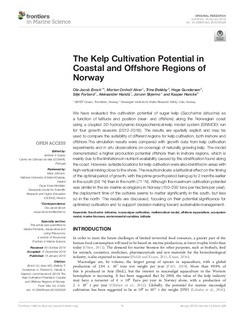| dc.contributor.author | Broch, Ole Jacob | |
| dc.contributor.author | Alver, Morten | |
| dc.contributor.author | Bekkby, Trine | |
| dc.contributor.author | Gundersen, Hege | |
| dc.contributor.author | Forbord, Silje | |
| dc.contributor.author | Handå, Aleksander | |
| dc.contributor.author | Skjermo, Jorunn | |
| dc.contributor.author | Hancke, Kasper | |
| dc.date.accessioned | 2019-01-22T20:26:40Z | |
| dc.date.available | 2019-01-22T20:26:40Z | |
| dc.date.created | 2018-12-31T09:12:23Z | |
| dc.date.issued | 2019-01-18 | |
| dc.identifier.issn | 2296-7745 | |
| dc.identifier.uri | http://hdl.handle.net/11250/2581857 | |
| dc.description.abstract | We have evaluated the cultivation potential of sugar kelp (Saccharina latissima) as a function of latitude and position (near- and offshore) along the Norwegian coast using a coupled 3D hydrodynamic-biogeochemical-kelp model system (SINMOD) run for four growth seasons (2012-2016). The results are spatially explicit and may be used to compare the suitability of different regions for kelp cultivation, both inshore and offshore. The simulation results were compared with growth data from kelp cultivation experiments and in situ observations on coverage of naturally growing kelp. The model demonstrated a higher production potential offshore than in inshore regions, which is mainly due to the limitations in nutrient availability caused by the stratification found along the coast. However, suitable locationsareas for kelp cultivation were also identified in areas with high vertical mixing close to the shore. The results indicate a latitudinal effect on the timing of the optimal period of growth, with the prime growth period being up to 2 months earlier in the south (58 °N) than in the north (71 °N). Although the maximum cultivation potential was similar in the six marine ecoregions in Norway (150-200 tons per unit area per year) in the six marine ecoregions in Norway, the deployment time of the cultures seems to matter significantly in the south, but less so in the north. The relevance of the results is discussed with a view towards use in decision support tools and a management context. The results are discussed, focusing on their potential significance for optimized cultivation and to support decision making towards sustainable management. | nb_NO |
| dc.description.abstract | The kelp cultivation potential in coastal and offshore regions of Norway | nb_NO |
| dc.language.iso | eng | nb_NO |
| dc.rights | Navngivelse 4.0 Internasjonal | * |
| dc.rights.uri | http://creativecommons.org/licenses/by/4.0/deed.no | * |
| dc.subject | Saccharina latissima | nb_NO |
| dc.subject | macroalgae cultivation | nb_NO |
| dc.subject | mathematical model | nb_NO |
| dc.subject | offshore aquaculture | nb_NO |
| dc.subject | ecosystem model | nb_NO |
| dc.subject | marine biomass | nb_NO |
| dc.subject | environmental variables | nb_NO |
| dc.subject | latitude | nb_NO |
| dc.title | The kelp cultivation potential in coastal and offshore regions of Norway | nb_NO |
| dc.type | Journal article | nb_NO |
| dc.type | Peer reviewed | nb_NO |
| dc.description.version | publishedVersion | nb_NO |
| dc.rights.holder | © 2019 Broch, Alver, Bekkby, Gundersen, Forbord, Handå, Skjermo and Hancke. This is an open-access article distributed under the terms of the Creative Commons Attribution License (CC BY). The use, distribution or reproduction in other forums is permitted, provided the original author(s) and the copyright owner(s) are credited and that the original publication in Frontiers in Marine Science is cited, in accordance with accepted academic practice. No use, distribution or reproduction is permitted which does not comply with these terms. | nb_NO |
| dc.source.journal | Frontiers in Marine Science | nb_NO |
| dc.identifier.doi | 10.3389/fmars.2018.00529 | |
| dc.identifier.cristin | 1647891 | |
| dc.relation.project | Norges forskningsråd: 267536 | nb_NO |
| dc.relation.project | Norges forskningsråd: 254883 | nb_NO |
| cristin.unitcode | 7566,6,0,0 | |
| cristin.unitname | Miljø og nye ressurser | |
| cristin.ispublished | true | |
| cristin.fulltext | original | |
| cristin.qualitycode | 1 | |

